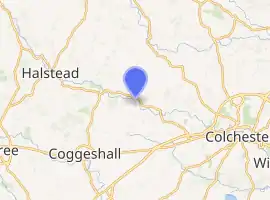Chappel Viaduct
The Chappel Viaduct is a railway viaduct that crosses the River Colne in the Colne Valley in Essex, England. It carries the Gainsborough Line which now is a short branch linking Marks Tey in Essex to Sudbury in Suffolk. The line previously, however, extended to Shelford in Cambridgeshire.
Chappel Viaduct | |
|---|---|
 The viaduct in 2006 | |
| Coordinates | 51.9209°N 0.7557°E |
| OS grid reference | TL896283 |
| Carries | Gainsborough Line |
| Crosses | River Colne |
| Locale | Essex, England |
| Maintained by | Network Rail |
| Heritage status | Listed structure |
| Characteristics | |
| Design | Viaduct |
| Material | Brick |
| Total length | 1,060 feet (320 m) |
| Height | 75 feet (23 m) |
| History | |
| Construction start | 1847 |
| Construction end | 1849 |
| Location | |

| |
It was completed in 1849 by the Eastern Union Railway, which was later absorbed into the Great Eastern Railway. It is the longest bridge in the East Anglia region at 1,060 feet (320 m), and one of the largest brick-built structures in the country. It was listed at Grade II in 1967.
Description
.jpg.webp)
The viaduct consists of 32 semi-circular spans, each of 30 feet (9.1 m) span with tapered piers; it is 1,060 feet (320 m) long and rises to a maximum height of 75 feet (23 m). The piers consist of two shafts, separated by a 6 feet (2 m) opening, and joined at the top and bottom by arches; each shaft contains a hollow void up to 4 feet (1.2 m) by 3 feet (1 m), partially filled with concrete to the level of the bottom arch. The running level of the viaduct has a gradient of 1 in 120.[1]
Construction
The seven million bricks used in the construction of the viaduct were made from clay excavated from the nearby village of Bures. It was built to carry a double-track railway but only a single track was laid. The bridge was built by Peter Bruff between 1847 and 1849 for the Colchester, Stour Valley, Sudbury & Halstead Railway, later part of the Great Eastern Railway.[1][2][3]
The railway initially planned to build the viaduct with laminated timber but Bruff opted for brick to reduce the cost.[4] He debated the cost benefits of brick compared to timber with the Great Western Railway's chief engineer Isambard Kingdom Brunel after a lecture at the Institution of Civil Engineers in 1850, Brunel being strongly in favour of using timber. Bruff went on to commission a painting of the viaduct by Frederick Brett Russell, which is now held by Ipswich Museum.[5] Sources differ on the cost of construction; E. A. Labrum gives the cost as £21,000, while Historic England state a figure of £32,000 (both 1849).[1][5]
A foundation stone in pier 21 was laid by the railway company's chairman and deputy chairman at the start of works in September 1847 and newly minted coins were placed inside as a souvenir. The stone and coins disappeared within a few hours of being placed and a bricklayer was later arrested, having tried to pay at a bar with a new half sovereign,[6] but was not convicted of the theft due to lack of evidence.[2]
Listing
The viaduct was designated a Grade II listed structure on 27 November 1967.[1][2] It is the longest bridge in East Anglia[5][7] and, was reported to have been built out of 7 million bricks and therefore the second-largest brick-built structure in England, after Battersea Power Station in London,[4] though Stockport viaduct used 11 million bricks.
References
- Historic England. "The Viaduct (1238766)". National Heritage List for England. Retrieved 21 February 2016.
- Biddle, Gordon. Britain's Historic Railway Buildings: A Gazetteer of Structures (Second ed.). Hersham, Surrey: Ian Allan Publishing. p. 236. ISBN 9780711034914.
- Bruff, P. (1850). "Description of the Chapple Viaduct, Upon the Colchester and Stour Valley Extension, of the Eastern Counties Railway". Minutes of the Proceedings. 9 (1850): 287. doi:10.1680/imotp.1850.24162.
- "Chappel Viaduct". BBC. 28 October 2014. Retrieved 21 February 2016.
- Labrum, E.A. (1994). "South Suffolk and Essex". Civil Engineering Heritage: Eastern and central England. London: Thomas Telford Publishing. p. 162. ISBN 9780727719706.
- Biddle, Gordon (2003). Britain's Historic Railway Buildings: An Oxford Gazetteer of Structures and Sites (First ed.). Oxford: Oxford University Press. p. 199. ISBN 9780198662471.
- "Chappel Viaduct". Engineering Timelines. Retrieved 3 March 2016.
External links
![]() Media related to Chappel Viaduct at Wikimedia Commons
Media related to Chappel Viaduct at Wikimedia Commons